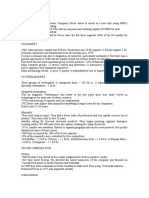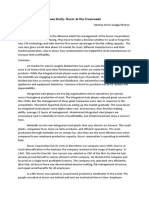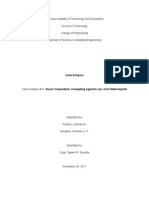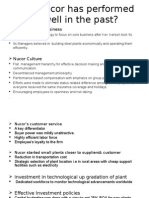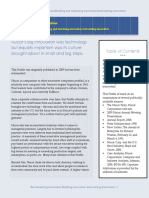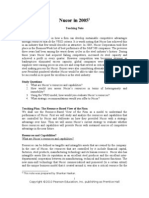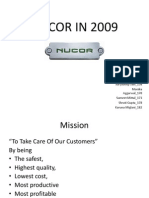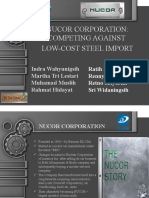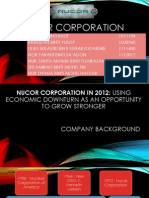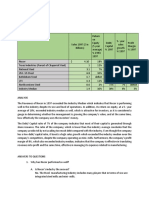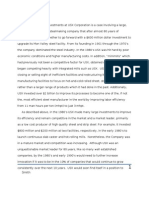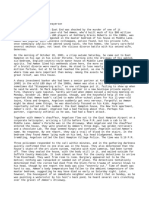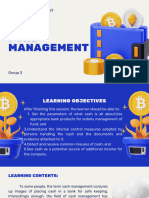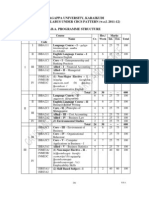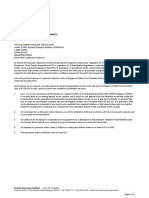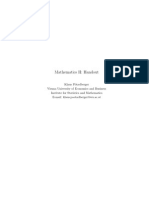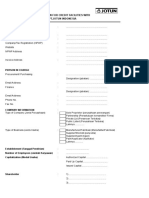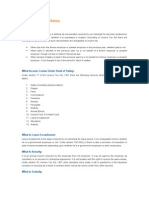Value Chain analysis
Even though Nucor allowed competitors to visit its plants (as long as the favor was returned), no
other company was able to imitate its success. The keys to Nucors success were, as already
detailed above, its team oriented, all in approach to the business. More than a mere mission
statement, this approach was the cultural lifeblood of Nucor and, due to Iversons commitment
and leadership, this philosophy permeated the workforce in a way that simply could not be
replicated by competitors with very different cultures. For example, Nucors Share the Pain
program, while easy to have during good economic times, became much more than a catch
phrase when Iverson took a substantial pay cut himself when times were tough. By contrast, the
CEO salaries at the integrated companies did not fall nearly as much as Iversons did when their
companies were struggling. This distinction was a defining characteristic for Nucor, and one that
made its strategy virtually impossible to imitate. The bottom line is that Iverson not only made
rules, he strictly followed them himself and thereby reinforced a highly disciplined, accountable,
and thus productive work force. It was these advantages that allowed Nucor, from 1975-1987, to
have an average return on assets of 10.06 percent, whereas the average in the mini mill
industry was 7.32 percent and the average for integrated companies was 1.24 percent. This
comparison is a good indicator of Nucors past performance, particularly with its return on
assets almost 40 percent higher than the mini mill average.
Nucor in the Thin Slab Casting Business:
Despite its solid performance in the mini mill industry, in order to expand into the thin slab
Casting business, Nucor realized that it would have to invest in compact strip production or
CSP, which SMS of West Germany was actively marketing to steelmakers around the world.
Indeed, this was a primary risk facing Nucors potential entry into this business that it might
gain only a two to three year head start by being the first adopter if others decided to be fast
�followers. The prospect of technological leapfrogging was another risk that is, as soon as
Nucor invested in a new thin slab plant, there was a chance that other cheaper, and more
technologically advanced methods of thin slab casting would be introduced. Yet another risk
was that if other minimill companies followed Nucor into the thin slab casting business, the
demand for scrap metal would likely rise, with a corresponding rise in its price. Its hould be
noted, however, that this risk was offset to some extent by Nucors utilization of David Joseph,
Inc. as its intermediary for procuring scrap metal. The complexity of a thin slab plant versus mini
mill plants would also pose potential operational risks. Financially, entering the thin slab
business would also be a stretch for Nucor, with only $185 million in cash and short term
securities (as compared to the cumulative $410 million that it would incur in capital expenditures
in the first three years of its investment due to its preexisting joint venture with Yamato Kogyo).
These, and other unknown rendered this business opportunity a significant gamble for Nucor.
Nucors competitors in the thin slab casting business would include the integrated steel giants
that already had a presence in the flat sheet market, such as U.S. Steel, LTV Steel, and
Bethlehem Steel. In addition, other aggressive mini mills would likely follow Nucor into the
market at the first sign of profitability. Chaparral Steel was an especially probable competitor,
with its reputation for progressiveness that was exceeded, perhaps, only by Nucors. North
Star, due to its sheer size, would also be a likely competitor from the mini mill market. Finally,
foreign steelmakers would remain an ever present competitor in this market as well. In 1986,
imports already comprised roughly 18 percent of the flat sheet market. With their low labor costs
and increasing steel quality, these foreign companies would be well positioned to challenge
Nucors profitability for many years to come (barring governmental intervention via trade
restrictions, etc.).
Despite the noted risks and competitors awaiting Nucor in the thin slab casting business, the
prospects for profitability were good. First and foremost, the flat sheet segment still represented
�half of the U.S. steel market. Second, the construction costs of a thin slab plant versus a
modernized integrated plant was $450 million and $1,873 million, respectively. Moreover, once
built, the thin slab plants operated more efficiently than their integrated counterparts and
therein was Nucors core promise of profitability in the thin slab casting business. Whereas
integrated steelmakers in the flat sheet segment took four to five labor hours per ton to produce
sheet steel, it was estimated that the same production could be achieved in a thin slab plant
with only 45 labor minutes per ton, providing Nucor with an estimated $50 $75 cost advantage
per ton, a 25 percent profitability edge on its competitors. With respect to its competitive
advantages in the thin slab casting business, Nucor has always quickly adopted new technology
to enhance its position in the marketplace. Indeed, one of its key competitive advantages has
been its unconventionally simple method for evaluating investment opportunities: will it perform
technically as advertised and do previous capital expenditures constrain Nucors full
commitment to the project in question? But prior to this investment opportunity, perhaps none
have required such an enormous amount of capital and degree of risk. Furthermore, even if
Nucor was able to achieve a first mover advantage, that advantage was likely to be short lived,
first, due to the likelihood that others would follow in Nucors footsteps (particularly with SMS
actively marketing its technology to more than 100 other steelmakers worldwide) and, second,
due to the probability that the compact strip production method would soon be surpassed by
increasingly productive technology and imitations from other competitors. As of 1986, SMSs
competitor, Mannesman Demag, was already working on and promoting a new method that
could potentially accomplish this. While the potential of new technology should always be
considered, it should not paralyze the decision making process for Nucor. By definition, where
success is achieved by one, imitation is attempted by many others. Again, likely imitators in this
case would be Chaparral Steel and North Star, especially in light of North Stars history of
entering nonstandard markets for mini mills, such as seamless pipes. To counterbalance this
reality, Nucor must simply continue to utilize every new investment that it makes in new
�technology as a catalyst for further innovation, perhaps evolving its thin slab casting plant to
manufacture not only ordinary steel, but stainless steel and other high demand steel products in
the future. Indeed, operating on the cutting edge has always been a key competitive advantage
for Nucor and, as long as it stays on that point, that should remain a powerful competitive
advantage for years to come.
Based on all of the aforementioned competitive considerations, Nucor should accept the risks
associated with investing in CSP technology and build a thin slab casting plant. Using Nucors
unique investing criteria that plants were supposed to achieve a 25 percent return on assets
within five years of start upand that projections about them were compared, whenever
possible, to historical data on other plants the applicable financial analysis supporting this
recommendation is set forth below:
RETURN ON ASSET FORECAST- OPERATION YEAR 1
Costs
Total Construction Costs
Capital Expenditures
Scrap Metal for (1Tonne of Production)
Materials & Supplies
TOTAL PLANT ASSETS
Revenue Per Ton
Costs Energy
Maintenance/Repairs
Start Up Costs
Taxable Income
Taxes (35%)
NET INCOME
RETURNONASSETS
Amount in million dollars
$280
$30
$100.5
$56
$466.5
$306.5
$24
$10
$30
$242.5
$84.875
$157.625
33.79%
�It is worth noting that further approximations could be calculated based on assumptions
concerning any debt incurred in connection with a new thin slab plant, the interest rate paid on
such debt, and tax rates, all of which could decrease the return on assets and cash flows.
Conversely, as the startup costs that would be incurred in the first year would not be owed in
ensuing years, both cash flow and the return on assets could be expected to rise. Likewise, it
stands to reason that after the initial startup year, the plant would operate with increased
efficiency and production levels and likely with reduced costs as well, which would tend to drive
the return on assets (and overall cash flows) even higher. In any event, looking at this potential
investment based on the financial criteria utilized by Nucor, it is clear that it would attain Nucors
25 percent return on asset target within the first five years of the plants startup, with a probable
increase thereafter.
Risks that could potentially affect Nucor's profits, other than those already discussed above,
would include a number of factors outside of its control, such as fluctuations in tax and interest
rates. Perhaps most importantly, increases in the price of scrap metal could potentially have a
significant adverse impact on Nucors profits, as would a decline in demand (and, thus, a drop in
prices) in the flat sheet segment.
Three tests of strategy:
Goodness of fit test:
Overall, the appropriateness of Nucors corporate and business strategy has been proven
correct since 1966. The corporate strategy addressed the critical issues in the external and
internal environment. The problem in mid-1960s was the convoluted and unprofitable corporate
structure. Nucor solved the problem by shifting to single business strategy. When it realized the
strategy of a backward integration is necessary, it switched from single business strategy to
�dominant-business diversifying strategy. In addition, when the introduction of new steel
production technology provided golden opportunities in the steel production market, Nucor
shifted its focus from steel product business to steel production business. As the steel
production market became saturated, Nucor considered moving to a related-link and probably
related-constrained diversification strategy. The appropriateness of Nucors corporate strategy is
a critical factor for Nucors success. The appropriateness of Nucors business strategy was
represented by its good fit with the external and internal environment.
Competitive Advantage test
Nucor adopted an integrated cost leadership/differentiation strategy with more emphasis on cost
reduction. The cost leadership approach takes advantage of the technological progress in the
external environment. As a result, Nucor reduce cost at a level that is substantially lower than
that of its competitors. On the other hand, Nucor evaluate and meet customers need by
providing variety of product mix. The differentiation approach was supported by both the
technological progress in the external environment and Nucors core competences of
technology innovation and continuous improvement. Nucors organization culture played a key
role in its cost reduction effort. It provided great support for Nucors business strategy. The
appropriateness of Nucors business strategy led to high profitability and competitiveness.
Risks
Changing energy price and raw material price can always be a threat for the steel industry.The
global competition is intensifying in developing new technology and investing in R&D. Nucor has
no global strategy to take advantage of the profitable opportunities in the global market. In the
near future the decline of the U.S. automotive industry and a potential decline of the
construction industry be a major obstacles the steel industry are likely to face. Moreover, with
respect to the question of whether this business is viable, it is clearly viable in the short term in
light of its substantial profitability potential and, even in the long term, it will be an important step
�toward the future in the event that Nucor adopts it. Thus, while the advantage might only last a
few years, not investing in the thin slab plant would be a significant opportunity missed. Even if
the CSP technology is leapfrogged by other developments or copied by imitators, all indications
are that the thin slab casting plant is Nucors gateway to the flat sheet segment and, since that
represents half of the U.S. steel market, it is a long term business prospect for Nucor,
regardless of the risks.
Flexibility
The global environment provides excellent market opportunities for Nucor while the U.S. steel
market is becoming saturated and shrinking. Global expansion has emerged as the best choice
for U.S. steel producers. Nucor has been relying heavily on the domestic construction and
automotive industry, with majority of its products sold to these two segments. In addition, the
global environment provides other benefits, such as low labor costs, low raw material costs, and
locations close to customers. It provides abundant supply of cheap resources and raw material.
Nucor may consider a backward integration by acquiring plants in the region. Global expansion
fits well with not only the external environment but also the internal factors of Nucor. Innovation
and risk taking are two key characteristics of Nucors corporate culture. They will provide good
support to Nucors global expansion. In addition, Nucors solid reputation and financial position
will facilitate its entry into the global arena.
The consolidation trend in the external environment provides good opportunities for Nucor to
expand through strategic acquisition. In addition, many steel producers shut down productions ,
resulting in good bargaining opportunities. Acquisition allows Nucor to improve effectiveness of
capital costs, renegotiate labor agreements, reduce labor cost, and increase managerial
efficiencies. The goal of acquisition is to expand the platform for generating earnings and
attractive returns.
�Strategic Issues and Problems:
